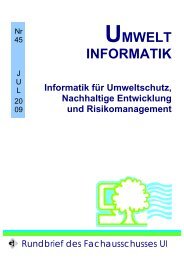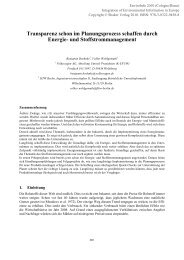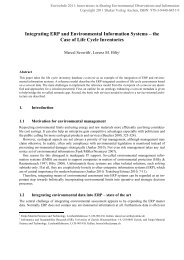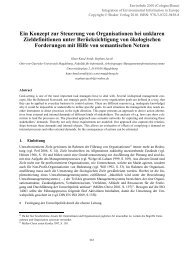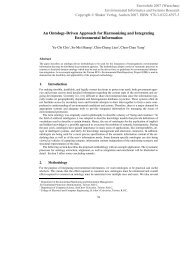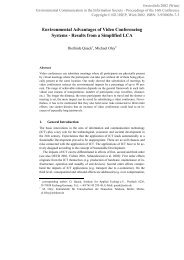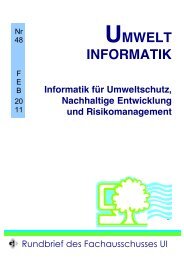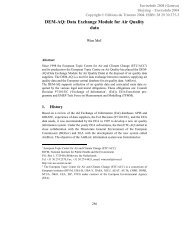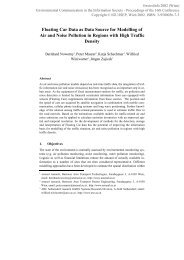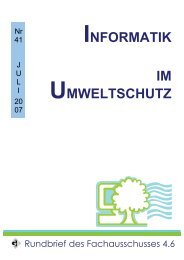Environmental ICT applications for eco-industrial ... - EnviroInfo
Environmental ICT applications for eco-industrial ... - EnviroInfo
Environmental ICT applications for eco-industrial ... - EnviroInfo
Create successful ePaper yourself
Turn your PDF publications into a flip-book with our unique Google optimized e-Paper software.
focus though is rather limited to the documentation of waste management following national laws <strong>for</strong><br />
handling hazardous substances (SAP 2005).<br />
2.4 Approach based on empirical studies<br />
The three classifications mentioned above take a deductive perspective, more or less. The approach<br />
based on empirical studies follows an inductive principle. In terms of empirical studies, pretty less had<br />
been done, yet. An exception is the analysis Grant (2007) has conducted. He analyzed case studies<br />
publicly available in the Industrial Ecology literature with the aim to assess the current progress of environmental<br />
<strong>ICT</strong> <strong>applications</strong> in supporting <strong>industrial</strong> symbiosis projects.<br />
In total, Grant (2007, 22-23) identified 16 environmental <strong>ICT</strong> <strong>applications</strong> built to facilitate <strong>industrial</strong><br />
symbiosis projects (tab. 1). Of the sixteen environmental <strong>ICT</strong> <strong>applications</strong> identified, one software<br />
tool is available <strong>for</strong> purchase on the internet; two are in use though they are not publicly available; <strong>for</strong><br />
nine there is no publicly available evidence whether they are still in use.<br />
Of the 12 environmental <strong>ICT</strong> <strong>applications</strong> identified, seven were developed in USA, three in<br />
Europe, and two elsewhere. Interestingly, the three operational <strong>applications</strong> were developed in Europe.<br />
Of course, these numbers merely provide a first impression of how environmental <strong>ICT</strong> <strong>applications</strong> are<br />
being developed and where they are being used.<br />
Based on his review over the past ten years, Grant (2007, 40) considered usability, training and expertise<br />
and high start-up costs as common critical challenges. He particularly found that environmental<br />
<strong>ICT</strong> <strong>applications</strong> he examined have strengths in technical opportunities when identifying potential<br />
physical exchanges. The <strong>applications</strong> identified, however, show much room <strong>for</strong> improvements in<br />
building relationships between people, enabling communication and facilitating co-operation.<br />
2.5 Impact-driven approach in terms of sustainability<br />
The impact-driven approach focuses on the effects <strong>ICT</strong> – and hence environmental <strong>ICT</strong> <strong>applications</strong><br />
– are causing in terms of sustainability (Hilty 2008). The point is that environmental <strong>ICT</strong> <strong>applications</strong><br />
surely provide an array of benefits and increase efficiencies on the one hand (Hilty et al. 2005); on the<br />
other hand, however, they also imply consequences, e.g. in terms of scarce resources, energy consumption,<br />
and electronic waste, just to mention a few (Geibler et al. 2005).<br />
228<br />
Copyright © Shaker Verlag 2009. ISBN: 978-3-8322-8397-1






